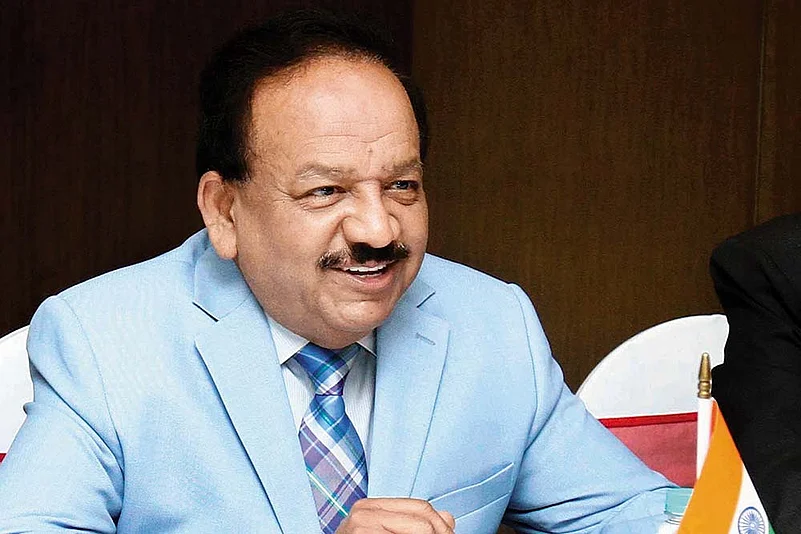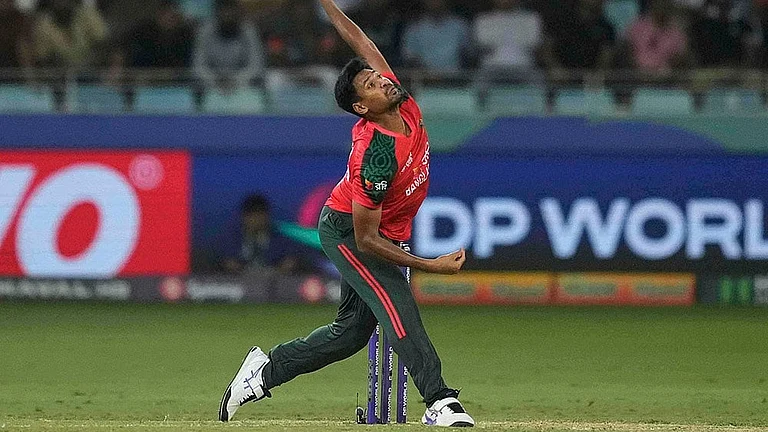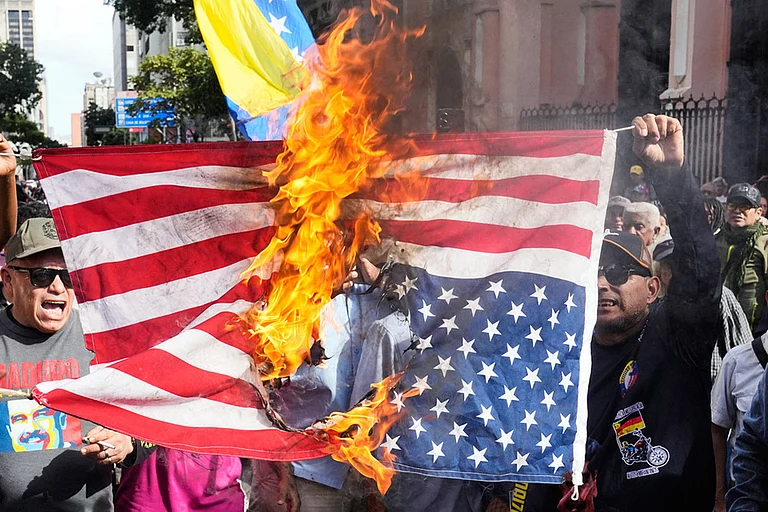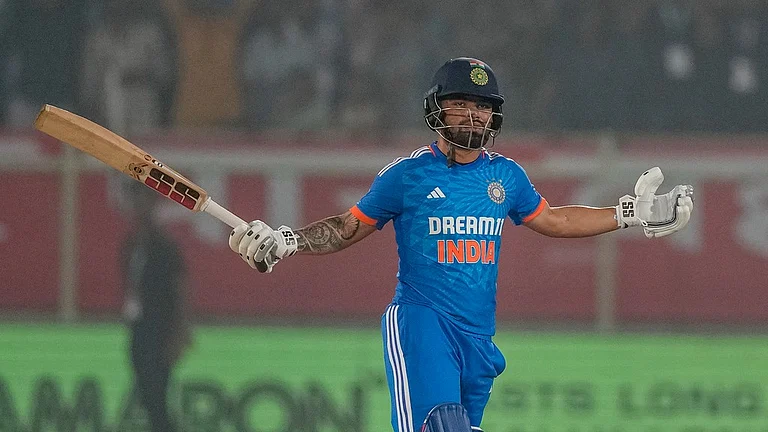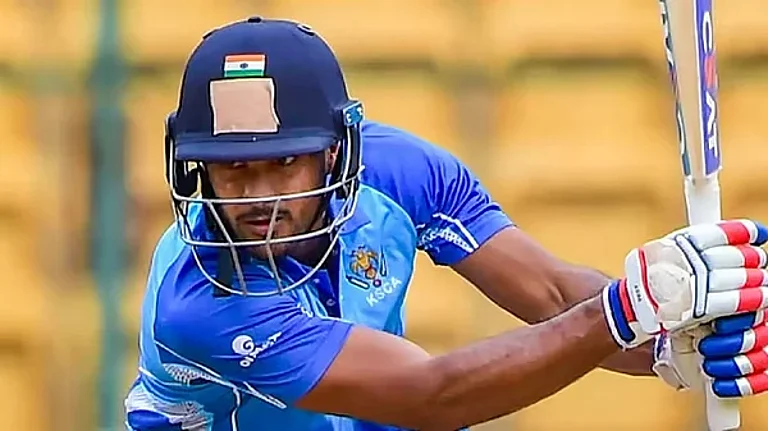In an exclusive interview, Union Health Minister Dr Harsh Vardhan tells Outlook that necessary manpower needed to administer the vaccine has already been mapped. Excerpts:
Q) India runs one of the world's biggest universal immunization programmes. Yet, in comparison, the Covid-19 vaccination effort will be even more gigantic. What are the big questions that the government is considering right now? At what stage are the preparations?
Yes, that’s very true. India has a robust immunisation coverage network in place. We are already implementing the largest immunization programme of the world, with ~26 million infants added every year. We have an established infrastructure for the supply, storage and delivery of vaccines to the last mile, under our Universal Immunization Program, where we are administering around 600 million doses to our children annually. Therefore, we have the experience of implementing large-scale immunization campaigns. We have also been carrying out largescale polio vaccination campaigns for more than two decades now. We have recently conducted the world’s largest Measles-Rubella Campaign covering more than 330 million children in the age group of 9 months to 15 years. We are further augmenting this system to ensure that the massive national mission of vaccinating the identified priority groups with Covid-19 vaccine is achieved in a timely manner. India’s accomplishment in eradicating polio is the most impressive global health success story that the world has ever seen. With that experience behind us, I have no doubt that we will achieve any target that we set.
A National Expert Group on Vaccine Administration for Covid-19 (NEGVAC) has been constituted under the chairpersonship of Dr V.K. Paul, member, health at NITI Aayog and the co-chairpersonship of Secretary HFW, Rajesh Bhushan, to guide on all aspects of Covid-19 vaccine introduction related to implementation mechanisms, selection of vaccine candidates, procurement mechanisms, financial resources. The national group has been meeting regularly and reviewing the preparatory steps for vaccine delivery.
We already have a robust system of electronic Vaccine Intelligence Network (eVIN) through which real-time information of vaccine stock availability and their storage temperature across all cold chain points is available.
Most importantly, our Prime Minister Narendra Modi has been fully involved in the subject and has been personally monitoring the vaccine aspect. With such strong political will and the immense ground-level work that we are doing, I would say that our preparations are on track and we will be able to successfully provide Covid-19 vaccine to all our citizens in a phased manner.
I have always believed that we have the relentless spirit, the scientific power, the business acumen, the manufacturing skill, the political imagination, and the vast human resources that can help us to face any challenge.
Q) Some of the vaccine frontrunners are hopeful of getting efficacy data by next month or year-end. Which are the candidates under consideration by the government currently?
The pace at which vaccines against Covid-19 are being developed is unprecedented. Globally, about 200 vaccine candidates on varied platforms are presently undergoing development of which about 40 candidates are in human clinical development. Nationally, nearly 30 groups, both academia and industry, are actively involved in development or collaboration or co-development and trials for Covid-19 vaccine in India. Of these, about 5 vaccines are in the clinical stage of development. These include:
• An indigenously developed DNA vaccine candidate, ZyCoV-D, by ZydusCadila, which has nearly completed its Phase II trials, is being supported by National Biopharma Mission, BIRAC, department of biotechnology, Govt of India.
• Inactivated whole virion candidate vaccine developed by Bharat Biotech International Ltd (BBIL) will be starting the Phase 3 trials this week itself.
Its vaccine candidate -Covaxin- has been developed in collaboration with the Indian Council of Medical Research (ICMR) — National Institute of Virology (NIV) using inactivated Sars-Cov-2, the virus that causes Covid-19.
• ChAdOx1-S, a non-replicating viral vector vaccine, developed by University of Oxford/AstraZeneca, is already in Phase III clinical trial stage of development by Serum Institute of India. Astra Zeneca proposes to seek emergency use authorization in UK this month.
• Russian vaccine Sputnik V (using non-replicating viral vector) has received DCGI approval for Phase II/III trials in India, applied for by their India partner Dr Reddy’s Lab.
• Biological E of USA origin is a protein subunit (recombinant) receptor-binding protein. It has been granted permission for Phase 1 & 2 trials in India.
Given the huge population of our country, we will be exploring multiple vaccine candidates subject to their licensing by the Drug Controller General of India (DCGI).
Q)India has the highest vaccine manufacturing capacity in the world. What is the approach the government is taking to tie up with manufacturers to ensure availability? As chairman of the executive board of the WHO, have you been able to play a pivotal role?
The government is deliberating with the available vaccine manufacturers and intricately planning each granular detail of availability of different Covid-19 vaccines in India, including their production, availability, delivery, supply chain, storage mechanisms etc. Our aim is to provide the Covid-19 vaccine to 30 crore Indians by August-September 2021. This is a good 22 per cent of our total population.
The Indian vaccine manufacturers who have vaccine candidates in various stages of clinical trials have been engaged in one-on-one discussions with the government through the NEGVAC to ensure timely supply of vaccines upon their availability. The ICMR-DBT team has also visited Dhaka recently to engage for Phase 3 trials for the Bharat Biotech vaccine.
Further, WHO has launched Access to Covid-19 Tools (ACT) Accelerator to accelerate development, production, and equitable access to Covid-19 diagnostics, therapeutics, and vaccines. One of the four pillars of ACT accelerator is the COVAX facility. It aims at securing 2 billion doses of Covid-19 vaccine by the end of 2021 for an assured supply of vaccine doses to the participating countries to cover some proportion of the participating countries population. India is one of the participating countries in the COVAX facility and is likely to benefit from this arrangement. As chairman of the WHO’s EB, I have the privilege of coordinating this humongous task and serving the citizens of the world. We are striving to ensure a fair and equitable allocation of the vaccines to the entire world through the COVAX facility.
Q) How will we go about a vaccine roll-out? Please can you elaborate on the various operational requirements in view of our current capacities and the eventual choice of the vaccine -- such as upgrading the eVIN network, ramping up the cold chain network, logistics, ensuring the supply of medical equipment such as syringes, and finally the availability of healthcare workers?
We already have eVIN under our Universal Immunization Programme which tracks all the vaccines in the country for stocks & storage temperature till the last facility in the country. eVIN will be used for tracking the Covid-19 vaccines once available. eVIN is being further enhanced to incorporate Covid-19 vaccination beneficiary management system (CVBMS) for individualised tracking of all beneficiaries. This modified module will also generate electronic vaccination certificate for each beneficiary. The work on the creation of a database of health care workers (HCWs) has already been initiated with a circulation of guidelines to all states and Union Territories and to other central ministries employing health care workers. Subsequently, the session sites for vaccination will also be mapped.
Vaccines are thermo-sensitive products and require specified temperature ranges for their storage and transport. We have a robust cold chain and supply chain management system for the Universal Immunization Programme. The same will be used for Covid-19 vaccine introduction as well. We have already carried out an assessment of additional cold chain requirement for Covid-19 vaccine across the country and are augmenting the same.
Procurement has already been initiated for ice-lined refrigerators, deep freezers, walk-in-coolers and walk-in-freezers to meet the enhanced requirement of cold chain space.
Estimation of other logistics like syringes etc. is also being done under the guidance of National Expert Group on Vaccine Administration for Covid-19 (NEGVAC) for ensuring their timely supply for the introduction of Covid-19 vaccine.
Under the guidance of the National Expert Group, we have mapped the necessary manpower needed to administer the vaccine. Besides ANMs, the nurses, medical officers, medical interns will be involved for this purpose.
India has several strengths in technology. Online training platforms like ECHO and iGOT will be utilized for capacity building of our large workforce for administering the Covid-19 vaccine as and when it is available.
Q) The expectation is that the initial doses of a vaccine will be available in mid-2021. Please can you elaborate on the considerations based on which the priority groups are being decided? What is the size of the population we are targeting in the initial year?
With the unprecedented scale of the pandemic, limited availability of vaccines initially, to maximize the health impact of vaccine introduction, we are prioritizing certain occupational groups and certain age-groups. This prioritization is currently being deliberated by the National Expert Group. Our first priority will be health care workers that will include all workers, medical or non-medical who are associated with government or private health facilities.
The second priority will be frontline workers of other departments that are being deliberated upon. This will be followed by other priority groups as guided by a national expert group on vaccine administration. The process of creation of a database of health care workers has been initiated, and the exact number of beneficiaries from this group for vaccination will be available on completion of the exercise. We have to keep in mind an important fact that 80 per cent of the deaths in India due to Covid19 have been in the age group of above 50 years.
Q) What is the current estimate of the costs involved?
One of the Terms of Reference for the National Expert Group is to provide guidance on financial resources required for procurement of Covid-19 vaccine and various options of financing the same. Our government is committed to providing the Covid-19 vaccine to each and every citizen of India and has enough resources to finance the same.
Q) The ongoing routine immunization is a critical component of healthcare in itself -- how do we ensure that this is not affected by a Covid-19 vaccination effort?
There is no doubt that the routine immunization programmes had suffered a setback initially due to the unprecedented scale and critical nature of the crisis that arose due to the outbreak of the pandemic. However, we seized the first available opportunity to set right this challenge and started work on a war-footing to ensure that our critical programmes such as routine immunization for women and children as well as our TB eradication goals do not take a hit.
With the possibility of Covid-19 vaccine introduction in the near future, we have asked the states to form high-level coordination groups at the state and district levels. Amongst the critical terms of reference of these groups is to ensure minimal disruption of Covid-19 vaccination on routine immunization and other health services. These coordination groups will analyse the state and district-specific challenges and bottlenecks and address them appropriately for continuity of routine immunization and other health services.
Q) In Europe, where the pandemic had appeared to come under control, there is now concern about a second wave and due to this, lockdowns have come back. How worried are you about the current situation in India given the festival season, elections and by-polls in many states and approaching winter?
Yes, we are well aware of the resurgence of cases that is being reported from the Americas (USA, Canada, Argentina) and Europe (France, UK, Spain, Germany, Belgium and so on). We have also taken cognizance of the fact that there is enhanced survivability of viruses in colder environments and also the propensity of viral infections to peak in winter months.
We have issued Standard Operating Procedures on preventive measures to contain the spread of Covid-19 during festivities. As far as upcoming elections are concerned, the Election Commission of India has also issued “Broad Guidelines for Conduct of General Election/Bye-election during Covid-19”.
We are in continuous interaction with all states and UTs. We have already advised states to hold VCs along with state DGPs and district authorities to ensure that clauses regarding penal provisions for flouting the guidelines related to physical distancing, mask-wearing etc. are inserted and guarantee is taken from the organizers of such events accordingly. We have also advised states to ensure that a strict watch is kept on all such festive activities as well as in marketplaces to ensure adherence to “Covid-appropriate behaviour”.
Our fight against Covid cannot be won without people’s participation. Realizing this, Hon’ble Prime Minister Mr Narendra Modi has launched a countrywide “Jan Andolan for ensuring Covid-19 Appropriate Behaviour”. The campaign aims to encourage People’s Participation (Jan Andolan) with the key messages of “Wear A Mask, Follow Physical Distancing, & Maintain Hand Hygiene”. This movement has been embraced by people of this country and I am quite sure this will have the desired impact.
Q) Kerala, for example, had been singled out as a state that responded efficiently to Covid-19 from the start. However, its infection numbers have been rising rapidly. What could have gone wrong? How are the other states faring?
Between January 40 to May 3, Kerala reported 499 cases and two deaths only and the majority of the confirmed cases were concentrated in Kasargod and Kannur districts. Later on, between May 4 to June 30, majority of the confirmed cases were found in Malappuram, Palakkad and Thrissur districts due to phased unlocking that had begun leading to increased movement of people across the borders.
In July 2020, local transmission of cases initiated largely from a fishing colony in Thiruvananthapuram followed by clusters in Ernakulum, Alappuzha, Kasargod, Kollam and Malapurram etc. This event changed the complete case trajectory of the state, principally in terms of the source of transmission. Spikes were seen in the state’s epidemic curve due to Onam festivities in August and September 2020. Kerala, which was reporting an average 2,000 cases daily in the first week of September 2020, reached 4,000 average daily new cases fortnightly and started adding 7,000-8,000 daily new cases to its tally by September-end. Unchecked movement of people due to trade, tourism, festivities and so on, increased the risk of transmission. Overwhelming active cases and high population density may be other factors that resulted in further community spread.
The other states should take a cue that festivities in the coming months, if not properly managed, especially in the context of Covid-appropriate behaviour, may see a sudden spurt in cases, as has been witnessed in Kerala.
While most states/UTs are showing a declining trend in the number of new cases being reported, a few like Delhi, Manipur, Meghalaya, Mizoram and West Bengal are still reporting an increasing trend in the last four weeks.
Q) With the healthcare system engaged in the Covid-19 response, what has been the impact on other illnesses?
We are following the situation very closely with regard to non-Covid essential services, especially diseases with high public health burdens, such as TB, influenza, vector-borne diseases and non-communicable diseases.
Like almost all countries in the world, Covid-19 has posed a public health challenge in India as well and has strained the public health delivery system. A case in point is the drop in TB notification rates (almost 45 per cent) that were witnessed in the initial months. A similar drop was also observed in notification rates of seasonal influenza and non-communicable diseases like hypertension and diabetes. The number of hypertensive patients enrolled under India Hypertension Control Initiative (IHCI) was reduced by 60 per cent by the month of April, but is now picking up. However, it will take some time to reach its pre-pandemic levels.
We believe that with a sustained focus especially in the last four months on non-Covid essential health services, the situation is showing signs of improvement.
This can be attributed to a number of reasons like (i) closure of public and private health facilities, (ii) Fear of contracting Covid-19 in an institutional setting, (ii) involvement of field health workers in Covid-19 activities, (iv) effect on public and patient mobility.
Regular reviews are being conducted with the states/UTs to ensure that essential non-Covid services do not get adversely impacted. Funding support has been provided to the states/UTs for engagement of additional human resource and for incentivising the existing human resource under the emergency Covid-19 response & health system strengthening package.
This has been done to ensure that non-Covid essential services are not adversely impacted. Detailed guidance on the continuation of these services has been given to states/UTs for health system preparedness and for each and every disease control program.
Q) Has the Feluda Covid-19 Testing kit been rolled out? Is it true that it is as good as qRT-PCR, and much faster as well? Does it mean that this has the potential to replace RT-PCR & Antigen Covid tests in India?
The Feluda technology, developed by one of our CSIR labs, has been licensed by TATA Medical & Diagnostics. Their kit, called TATA Check, has been approved by DCGI. ICMR has notified its use on October 22. NABL is in the process of ensuring that labs that use this technology but lack qPCR machines will be accredited.
To answer the second part of your question, the reason that the Feluda technology is similar to qRT-PCR (quantitative reverse transcription-polymerase chain reaction), while being much faster, is that only the q (quantitative) part has been replaced. This quantitative part that gives Ct values during detection needs a qPCR machine that measures the fluorescence of the product with every cycle of PCR. This makes it very specific but also slow. Techniques that use RT-PCR without the qPCR machine have previously been non-specific because a wrong PCR reaction will also be detected. Otherwise, a simple RT-PCR run takes only 30 minutes. The Feluda technology uses a specific CRISPR to bind to the PCR reaction product and if the binding happens, it generates a band on a paper strip. This gives it the sensitivity and specificity of qRT-PCR but reduces the time by 2 hours and eliminates the need for 20-30 lakh qPCR machines.
It is yet premature to say whether this test will replace RT-PCR and Rapid Antigen Tests (RAT) for Covid-19.
Q) Is the virus mutating in India? You are on record saying that no mutation of coronavirus has been detected in India, which is either more transmission efficient or more pathogenic.
Let me give you the ancestry of the circulating SARS CoV-2 in India. As many as 2,276 virus samples from VRDL across the country were taken. Sequences from other institutions retrieved from GISAID network were also used. The whole genome sequencing was done. We found the variation in clades less than 1 per cent which is not really significant for virulence.
We believe that the virus is genetically stable so far. The pan-India 1000 SARS-CoV-2 RNA consortium sequences viral whole genomes of 1062 Covid-19 positive individuals. Whereas haplotype diversities peaked between March-May which was the early part of the outbreak, A2a (20A/B/C) emerged as a predominant haplotype. The temporal haplotype diversities landscape appears to be similar pan-India.
Q) For a country like India, surveillance is the key to controlling the pandemic. Are we only using antigen kits or are we conducting antibody testing as well?
RT-PCR and Antigen based tests are mainly being used for providing laboratory diagnosis of the disease primarily for treatment and contact tracing. Molecular closed system platforms like TrueNat and CBNAAT are also used for disease diagnosis. Different states are using varying proportions of the diagnostic tests.
Antibody-based IgG ELISA/ CLIA tests are being used for repeated serosurveys which are being conducted by various states as well as ICMR. ICMR has so far conducted two nationwide sero surveys using antibody tests in 24,000 and 28,000 individuals respectively in 70 districts of the country. Antibody-based IgG tests help in understanding the proportion of the population exposed to infection and recovered including asymptomatic cases.
Q) How can the government give Bharat Biotech Phase III clinical trial approval when its Phase I and Phase II vaccine trials are not even available for peer review?
Peer review is neither prescribed in NDCT Rules nor mandatorily required before allowing the subsequent phases of a clinical trial for any new drug, including a vaccine.
In case of M/s Bharat Biotech, the safety and efficacy results of Phase I/II clinical trial generated by M/s Bharat Biotech were evaluated in consultation with Subject Expert Committee (SEC) for consideration for the grant of Phase III clinical trial.
Based on the results and the recommendation of the SEC, CDSCO has granted permission for conduct of Phase III clinical trial with the vaccine and simultaneously requested the firm to submit a complete clinical trial report of Phase I/II clinical trial as & when completed.
Q) How does the Phase 1 and Phase 2 clinical trial compare for various vaccines under trial in India — size, endpoints, participant, demographics and so on?
Vaccines are heterogeneous in nature. Therefore, vaccines from different manufacturers may differ in respect to technology/platform used in their manufacturing. If the platform used is a new one, it is treated accordingly to ascertain the safety and efficacy of the vaccine.
In India, for example, permission was granted to conduct phase I/II clinical trials of vaccines for Covid-19 to M/s Bharat Biotech and M/s Cadila Healthcare Limited wherein the technology/ platforms used by the firms are different.
However, the primary endpoints and secondary endpoints, sample size, population etc. of the two studies are comparable.
The primary endpoint in both the Phase I clinical trials are safety assessment while that in phase II clinical trials are immunogenicity assessment.
The secondary endpoint in both the Phase I clinical trials are immunogenicity while that in phase II clinical trials are safety assessment.
The details of the trials of both the firms are available in public domain on the Clinical Trials Registry of India website (www.ctri.nic.in).
Q) What are the uncertainties that you face as you tread on this difficult path of your mission to provide the must-have vaccine to each and every citizen of the country?
You see, there are several uncertainties. The biggest is that the vaccine may not work. The next biggest challenge could be that the vaccine availability could be slower than what we have calculated. Vaccines may have to be imported, which will then throw up the need for reprioritization. Then there is a scientific fact that the vaccine efficacy may wane after 6-12 months.
However, I am an eternal optimist. I feel that there are so many candidate vaccines in the pipeline. The whole world is collaborating like never before. We are sharing solutions. Once a part of the population is vaccinated, cases will decline even further making it far easier for us to significantly contain the virus. And of course, there could be a good chance that we may not even need to vaccinate the entire population!
Q) What have been your lessons from the pandemic?
There has been immense learning from this catastrophe. The pandemic has taught us that therapeutics, diagnostics, and vaccines for the whole world is the only way out. Global collaboration is paramount. Governments, industry and philanthropy must pool resources to pay for the risk, the research, manufacturing and distribution, but with the condition that the rewards should be available to everyone, regardless of where they have been developed. We need to also focus on creating effective health systems for improved pandemic preparedness.
There is strength in numbers. We learn more, and faster, together – and the pandemic is underscoring the critical role of international collaboration on the frontiers of science and technology. It is acting as a pilot study in global collaboration. Today, many international corporations are working together to produce vaccines. This has also challenged the model of competition and taught us to transcend the traditional boundaries of knowledge production, dissemination, and consumption.
Now that we are on the threshold of a vaccine for Covid-19, THIS is the time to ensure that access to diagnostics, therapeutics, and vaccines is fair and equitable. Access to protection from a dreaded pandemic should not — and cannot be — a factor of the ability to pay.
The only exit strategy from Covid-19 is through science. Open science is a powerful tool to contribute to sustainable development goals. International collaborations in scientific research should become the norm and not the exception.
There has been one more learning from the pandemic, and this is spiritual. India has once again shown to the world that when its people set an ambitious goal, more than a billion minds get ignited and India’s promise on delivery against social responsibility can be endless!






